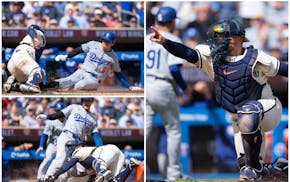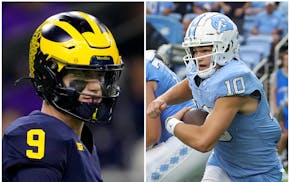Tyler Duffey had a breeze of a workday Sunday. He was in and out of the game so fast he barely broke sweat.
Duffey took the mound in the fifth inning of a 12-8 win over the Kansas City Royals. He faced three batters, threw only 12 pitches, nine for strikes, including six swing and misses. He fanned the side.
It was surgical, over in a blink.
"I'm having fun right now," Duffey said earlier in the day.
No kidding. In one of the more remarkable developments in a Twins season filled with them, Duffey has quietly become one of Major League Baseball's most dominant relievers one season after languishing in the bullpen.
Duffey extended his MLB-leading scoreless innings streak to 22⅔ innings on Sunday. He owns a 2.26 ERA for the season, and in his past 12 appearances, he has 22 strikeouts with no walks and only six hits allowed.
As many of us begged and screamed for pitching help at the trade deadline, the organization found one major upgrade from an unlikely source. In house with Duffey.
"He's turned himself into one of the best relievers in baseball," manager Rocco Baldelli said. "The second half of the year, how many guys can we really say have been better than him? I wouldn't say very many."
Duffey's reclamation project is a testament to data-driven development under the Twins new front office and coaching staff led by pitching coach Wes Johnson.
The Twins view their analytics operation as top-secret information. They don't allow noisy reporters to peek behind the curtain too often to glean insight into their systems and processes employed to gain an edge in different areas.
Duffey's rebound serves as ample evidence.
Johnson and assistant pitching coach Jeremy Hefner flew to Houston before spring training to visit with Duffey about changes they wanted him to make. They presented data that showed his pitching repertoire would be enhanced by throwing the ball in different locations. The gist: ditch the sinker, elevate his four-seam fastball.
The coaching staff met with the entire pitching staff in small groups again when they convened in Fort Myers. Same message: "Look, throw it to these spots and you'll be successful," Duffey said.
"It was strictly swing-and-misses," he said. "Where do you get those bad swings at?"
Duffey came up as a sinker ball pitcher taught to keep the ball down, so this was a fundamental shift in philosophy. Once a starter but relegated to long relief by 2018, Duffey was open to new ideas after bouncing between Rochester and the majors last season.
"We have guys [coaches, staff] that really know what they're doing," he said. "I knew Wes was brought in for a reason, and Hef was doing our scouting last year so I already had a level of respect and trust with him. When they told me, 'If you do this, you will be successful,' it was hard not to buy in. I was in from Day 1."
Duffey admits he didn't understand or know how to apply all the different analytics available to him initially with the new regime. He felt more comfortable with the information by spring training.
He throws his sinker only occasionally now, relying primarily on his fastball and curveball. That combination — plus an uptick in velocity — has produced more strikeouts and whiffs.
Duffey's swing-and-miss rate this season stands at 15.3%, which ranks 25th among all relievers. That's almost double his rate in 2016.
Duffey has recorded 78 strikeouts in 55⅔ innings. He's one of three Twins relievers to post 75 strikeouts this season, a first in team history.
He credits some of his increased velocity on a change of grip. He uses more finger pressure on the ball now and moved his fingers closer together. His arm also feels fresher as a late-inning specialist instead of high-volume long reliever.
Those changes added several miles per hour to his fastball, now consistently in the mid-90s.
"I was like, 'Well OK, this is kind of cool,'" he said.
That sums up his metamorphosis from fringe contributor to valuable strikeout machine. Kind of cool.
Scoggins: 'Wait one more year' can't be the Wild's plan. Thankfully, it isn't.

Scoggins: Finch feeling heat of the Suns as playoff battle looms
Scoggins: Why 'championship or bust' fits these Wolves

Scoggins: Anatomy of a game-saving play as Correa throws out Ohtani


